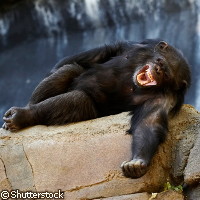Coochie-coochie coo... apes laugh too!
Can you name one thing that human and primate infants have in common? If you said laughter, you hit the nail on the head. A new study, the first phylogenetic test of the evolutionary continuity of a human emotional expression, provides evidence that the hooting and hollering sounds emanating from the mouths of primates are indeed laughter. The findings are published in the journal Current Biology. The researchers from the University of Portsmouth in the UK, the University of Veterinary Medicine Hannover in Germany and Georgia State University in the US tickled 22 infant and juvenile primates (7 orang-utans, 5 gorillas, 4 chimpanzees, 5 bonobos and 1 siamang) as well as 3 human infants, and analysed the acoustics of the resulting vocalisations. Dr Marina Davila Ross of the Centre for the Study of Emotion at the University of Portsmouth explained that humans make laughter sounds on the exhale. Even though chimps, for example, do the same, they also have the ability to laugh with an alternating flow of air: on both the inhale and exhale. The acoustic data was analysed using a quantitative phylogenetic approach, which focuses on the evolutionary development of organisms. The results showed that there were strong evolutionary relationships among the laughter sounds; the researchers were able to replicate the 'tree topology' established by genetic links among humans and great apes. 'Taken together, the acoustic and phylogenetic results provide clear evidence of a common evolutionary origin for tickling-induced laughter in humans and tickling-induced vocalisations in great apes,' the study reads. 'At a minimum, one can conclude that it is appropriate to consider 'laughter' to be a cross-species phenomenon, and that it is therefore not anthropomorphic [suggesting human characteristics] to use this term for tickling-induced vocalisations produced by great apes.' The findings also indicate that while the evolutionary origins of human laughter can be traced back at least 10 million to 16 million years - to the last common ancestor of humans and modern great apes - the origins may be even earlier. This theory was supported by the researchers' observation that tickling-induced vocalisations from the single siamang assessed in the study showed a number of similarities to orang-utan laughter. 'Consistent with the postulate of gradual evolutionary change from non-human displays to human emotional expressions by Darwin and others, analyses indicated both that there is significant acoustic variation in the tickle-induced laughter of great apes and that distinctive features of human laughter could have been shaped through selection and exaggeration of pre-existing traits,' the study concludes. In a nutshell, while the study shows that tickling-induced human laughter is deeply grounded in human biology and is acoustically and perceptually distinct from homologous great-ape sounds, the researchers explain that 'the evolutionary changes occurred along existing dimensions of variation, rather than being de novo inventions'. The results could also have implications for language evolution, according to the study, 'because human speech is also marked by consistently regular vocal-fold vibration and sustained, consistently egressive [pushing air out through the mouth or nose] airflow'. According to the researchers, future efforts will focus on why the particular acoustic properties emerged, and what functions they may have served as laughter found a solid niche in human social communication.
Countries
Germany, United Kingdom



